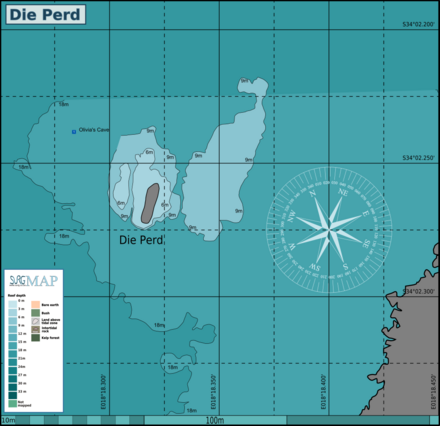Diving the Cape Peninsula and False Bay/Die Perd - inshore dive site at Duiker Point on the Cape Peninsula west coast
The dive site Die Perd is an inshore, rocky reef in the Karbonkelberg headland area on the Atlantic seaboard of the Cape Peninsula, near Cape Town in the Western Cape province of South Africa.
Understand

 See also: Diving the Cape Peninsula and False Bay#Understand
See also: Diving the Cape Peninsula and False Bay#Understand
Position
- Die Perd 📍: S34°02.282' E018°18.320' — (approximate). A rock off Duiker Point, and the reef around it.
This site is in the Table Mountain National Park Marine Protected Area since 2004. A permit is required. The site is within the Karbonkelberg restricted area.
Name
"Die Perd" is the name for this rock on the SA Navy charts of the area. It translates to "The Horse", and is probably a reference to the shape of the visible part of the rock which from some angles looks a bit like the back of a horse.
Depth
Maximum depth is about 25 m, and the top of the pinnacle is above the water. Average depth on a dive is likely to be about 15 m.
Visibility
Visibility is likely to be much like the other reefs in this area. Usually better than 5 m if divable, and possibly as good as 20 m after an upwelling and before the algal bloom.
Topography
The site is centred on a large outcrop of granite which extends above the surface and gives the site its name. The reef is low granite corestone reef in deep areas, with large boulders and outcrops and deep gullies in the shallower places. There are some minor swim-throughs and overhangs. The relief is more rugged and interesting in the north of the site where there are some very nice walls in the 10 to 15 m depth range.
Geology: Late Pre-Cambrian granite corestones of the Peninsula pluton.
Conditions
The site is exposed to westerly swells and wind, and also, though the fetch is short, to south easterly winds and wind chop. The wind chop will not usually affect the diver when underwater, but can make recovery by the boat relatively difficult, particularly if there is wind driven spray. South-westerly swell will significantly affect diving due to surge conditions, as the site includes quite shallow areas. The site is usually at its best in summer but there may also be occasional opportunities during autumn and early winter. Note that in summer the south east wind may pick up from a calm morning to strong or even gale force by afternoon. This is reasonably predictable and the weather forecast should be consulted.
This is an area which sometimes has upwellings, caused by the south easterly wind, resulting in cold, clear water, sometimes followed by a plankton bloom, which reduces the visibility again.
Keep a lookout for times when the forecast is for low short period south westerly swell and light winds, as this will indicate a reasonable chance of good conditions.
Get in
See also: Diving the Cape Peninsula and False Bay#Boat dives
Access to the site is only possible by boat. The site is not very far from the shore, but there are no roads to this area.
The site is about 7.2 km from Hout Bay harbour.
See
Marine life
See also: Diving the Cape Peninsula and False Bay#The marine ecology
Not much variety in deeper areas, but some very nice walls in the 10 to 15 m range. Hard corals, sea fans, lots of sponges, hydroids, bryozoans, starfish etc. Some large areas of urchins. The silver tip and Gas flame nudibranchs are fairly common. Kelp grows on top of the rocks, and there is a good diversity of smaller seaweeds above 9 m. Red bait covers the tops of the reef in shallower areas. <gallery mode=packed> File:Laminaria pallida (top) and Ecklonia maxima (below) P3290141.JPG|Two species of kelp File:Cf Plocamium sp P3290021.JPG|Red seaweeds File:Red bait Pyura stolonifera P3290020.JPG|Red bait File:Colonial ascidian at Duiker Point P3290083.JPG|Colonial ascidian File:Bunodactis reynaudi P3290098.JPG|Sandy anemones File:Eunicella papillosa P3290075.JPG|Nippled sea fans File:Parechinus angulosus P3290084.JPG|Cape sea urchins File:Clinus sp P3290138.JPG|Klipfish File:Cf Neuroglossum binderianum P3290015.JPG|Red seaweeds </gallery>
Photography
Macro photography is most likely to produce satisfactory results, as there are lots of subjects, while the topography is not particularly spectacular.
Routes
No specific routes recommended. The reportedly more interesting areas are to the north-west of the exposed rock, below 18 m.
Stay safe
See also: Diving the Cape Peninsula and False Bay#Stay safe
Hazards
Cold water, strong surge, particularly in the shallower areas around the exposed rock on the seaward side.
Skills
No special skills required.
Equipment
See also: Diving the Cape Peninsula and False Bay#Equipment
No special equipment required, dry suit recommended.
Nearby
Back to the Alphabetical list of sites, or list of dive sites in the Outer Hout Bay area
Other regional dive sites:
Die Perd
Timezone:MultipleCoordinates:-34.04, 18.31